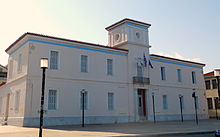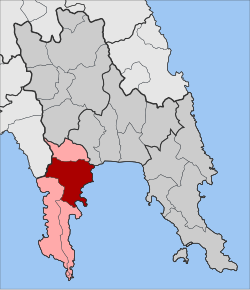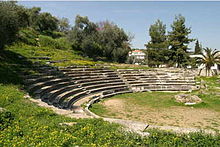Gythio
|
Municipality of Gythio Δημοτική Ενότητα Γυθείου (Γύθειο) |
||
|---|---|---|
|
|
||
| Basic data | ||
| State : |
|
|
| Region : |
Peloponnese
|
|
| Regional District : | Laconia | |
| Municipality : | Anatoliki Mani | |
| Geographic coordinates : | 36 ° 46 ′ N , 22 ° 34 ′ E | |
| Height above d. M .: | 61 m (average) |
|
| Area : | 197.313 km² | |
| Residents : | 7,106 (2011) | |
| Population density : | 36 people / km² | |
| Code No .: | 430201 | |
| Structure: |
1 city district 17 local communities |
|
| Website: | www.gythio.net/gr/gr_dimos.htm | |
| Located in the municipality of Anatoliki Mani and the Laconia regional unit | ||
Gythio ( Greek Γύθειο ( n. Sg. ), Pronunciation: [ˈʝiθio] , ancient Greek Γύθιον ) is a Greek port city on the Laconic Gulf in the south of the Peloponnese in the prefecture of Laconia . Gythio has been a municipality since the administrative reform of 2010 and is the seat of the municipality of Eastern Mani ( Anatoliki Mani ).
location
Gythio is located in a small, fertile delta of the Xeras River, framed by the foothills of the Taygetos Mountains, whose highest peak, called "Profitis Ilias" at 2407 meters, is a direct city backdrop when the visibility is good - often snow-covered until May. A source of drinking water rises in the middle of the plain and on the northern edge of the delta there are some small perennial streams. The bay of Gythio naturally offers good protection for ships. The port that has been expanded today is a ferry port for connections to the island of Kythira and to Kissamos on Crete .
Near the port is the small island of Marathonisi (the ancient Kranaë) with a pine forest and a lighthouse. It is connected to Gythio by a dam and picturesquely delimit the cityscape from the open sea. Paris and Helena are said to have spent their first night of love here on their flight from Sparta to Troy .
history
Bronze age
The oldest finds come from the island of Marathonisi . Here were Bronze Age shards found; the oldest can be dated to the Early Helladic . The settlement covered about half of the island during the Mycenaean palace period ( SH III) and was therefore a not insignificant place. Mycenaean burial chambers and the remains of a tholos were also discovered on Mount Mavrovouni , 2 km south of Gythio . These and other finds in the vicinity suggest a Mycenaean center. At the end of the Bronze Age, the settlement on the island was abandoned.
Antiquity
The origin of the Doric settlement Gythion ( ancient Greek Γύθιον, Γυθεῖον ) on the mainland opposite remains in the dark. It was a Periöken city dependent on Sparta . After the Spartans at the beginning of the 5th century BC After having expanded the port, it became the main port of Sparta, 45 km away, and the older port near Las , 7 km to the south, lost its importance.
As the main port of the Spartan fleet, Gythion has faced repeated enemy attacks. So in the year 455 BC Chr. Tolmides the Athenian fleet against Gythion and burned the harbor down. Nevertheless, this war between Athens and Sparta leads to the defeat of Athens. Also in the Peloponnesian War (431–404 BC) Gythion was the starting point of the Spartan fleet. In 407 BC Before his return to Athens , Alkibiades landed here and supervised the construction of thirty triremes by the Spartans.
After the Battle of Leuctra , Epaminondas fell in the winter of 370 BC. BC entered Laconia with a land army of the Boeotian League , but was unable to take Sparta. The army moved to the coast and besieged Gythion for three days without success, after which the army turned back.
During the First Macedonian War fell in 215 BC. BC the Macedonian army under Philip V entered Laconia and besieged Gythion without success on its advance to Cape Tainaron .
195 BC In the Second Macedonian War, the Roman general Titus Quinctius Flamininus succeeded in taking Gythion, allowing the Spartans to retreat to Sparta. Gythion remained contested and the Spartan king Nabis succeeded in 192 BC. To take the city, but the Spartans could not hold out long. Together with the other cities torn from Sparta, Gythion was placed under the protection of the Achaean League by Rome . When Greece in 146 BC Was converted into a Roman province , these cities joined to the " Lacedaemonian League ".
Around 70 BC There was apparently a stasis in the city, which could be resolved by an external arbitrator.
The “League of Eleutherolacons ” was founded under Emperor Augustus . Gythion was one of the few Eleutherolacon cities that issued its own coins, which testifies to the importance and wealth of the city.
During the Roman period, Gythion (Latin Gythium) experienced its economic heyday. In addition to brisk trade, prosperity developed primarily through the mining of marble and wood from the nearby oak forests of the Taygeton. Research remains controversial about the importance of the purple snail fishery. The city was greatly expanded. Among other things, a theater was built in the eastern flank of the Acropolis and thermal baths were built. Aqueducts brought fresh water to the city from the north and west, which was collected in a cistern on the western slope of the Acropolis. The city eventually extended to the slopes of the northern hills. South of the city across from the island of Kranae was the Migonion, a sacred area in which Aphrodite Migonitis was especially worshiped.
The reason for the decline was probably on the one hand that the sea level rose by a few meters in the first centuries AD. This flooded the port and parts of the city near the coast. In addition, the clearing of the forests is likely to have led to erosion, with corresponding consequences for agriculture. The piracy also increased strongly in late antiquity.
middle Ages
In the 6th century there were severe crises in the Balkans and the Aegean Sea and the economy collapsed. Many cities were abandoned then. The bay of Gythion may have been called by ships to collect drinking water or to trade local products, but no archaeological or written evidence from this period is known.
Modern times

In the 16th century, the coastal town of Paleópolis ("Old City") is called, which refers to the ruins of ancient Gythion.
Tzanet Bey Grigorakis, who controlled the Mani from 1782 to 1798, built a small settlement with a harbor opposite the island of Marathonisi, at the point where the Migonion was in antiquity. He named the place after the island of Marathonísi , while the delta with the ancient remains was called Paleópolis . His nephew Andon had a tower built in the north of the new settlement. Around 1820 the place already consisted of around 100 houses.
The city and island of Marathonisi played an important role during the Greek Revolution (1821–1829); many freedom fighters came here and at the end of the freedom struggles the place had 674 inhabitants. In 1865 Marathonisi was officially renamed Gýthio after the ancient name .
Since the medieval Mani society, characterized by piracy and feuds, could not survive in modern Greece, many maniots migrated to the cities. Gythio quickly developed into a small port town that already had 3,686 inhabitants in 1889.
At the beginning of the 20th century the city expanded into the delta and a new town with a chessboard-like floor plan was created. At the same time, the island of Marathonisi was connected with a pier, so that a larger outer port was created next to the older inner port. The city's population grew continuously and reached almost 7,000 inhabitants when the Second World War broke out .
Bombs were dropped on Gythio during World War II and people began to migrate. In the subsequent Greek Civil War (1946-1949) Gythio suffered from the communist guerrilla warriors who operated from the nearby Taygetos Mountains. Since the port of Gythio is not deep enough for modern merchant ships, it lost its importance as a transshipment port, and freight traffic to Laconia was increasingly shifted to the road. In 1961 the population was just under 5000 people.
Gythio was the administrative center of the former province of the same name within the prefecture of Laconia, which also included eastern Mani . In 1997 it became the seat of a larger municipality of Gythio, which was integrated into the municipality of Anatoliki Mani in 2010 and continues to exist there as a municipality.
Character and sights
Gythio is a small town with a long harbor promenade, steep stairs and picturesque alleys that give it a traditional Greek atmosphere. From its ancient past, the city now only has a small Roman theater to offer; many architectural witnesses sank below sea level in an earthquake in the 4th century AD. Witnesses of the heyday in the 19th century are numerous houses of neoclassical architecture on the mountainside above the harbor, some of which are now in decay, some have been lovingly restored.
The beaches of the village of Mavrovouni, which belongs to Gythio, are especially popular with camping tourists.
Gythio is the end point of the European route 65 starting in Malmö on the Greek mainland, it will continue on Crete.
literature
- Christian Le Roy: Gythelon or Gythion, Lakonia, Greece . In: Richard Stillwell et al. a. (Ed.): The Princeton Encyclopedia of Classical Sites. Princeton University Press, Princeton NJ 1976, ISBN 0-691-03542-3 .
- Yves Lafond: Gyth (e) ion. In: The New Pauly (DNP). Volume 5, Metzler, Stuttgart 1998, ISBN 3-476-01475-4 , column 37.
- Edward S. Forster: Gythium and the NW Coast of the Laconian Gulf . In: Annual of the British School at Athens 13, 1906-1907
- Graham Shipley: Lacedaemon . In: Mogens Herman Hansen (Ed.): An Inventory of Archaic and Classical Poleis . Oxford 2004, ISBN 0-19-814099-1 , p. 582.
- Helen Waterhouse & R. Hope Simpson: Prehistoric Laconia: Part II; in: The Annual of the British School at Athens 56; p. 114.
- JM Wagstaff: A Small Coastal Town in the Southern Greece: Its Evolution and Present Condition ; in: The Town Planning Review , Vol. 37, No. 4 (1976); pp. 255-270.
Web links
- gythio.net
- Information from the Roman-Germanic Central Museum for Prehistory and Early History in Mainz on the ancient port of Gythio (English)
- http://www.greek-tourism.gr/gythio/indexuk.htm
- http://www.mani.org.gr/horia/dgithiou/githio/gith/githio.htm
Individual evidence
- ↑ Results of the 2011 census at the National Statistical Service of Greece (ΕΛ.ΣΤΑΤ) ( Memento from June 27, 2015 in the Internet Archive ) (Excel document, 2.6 MB)
- ↑ Helen Waterhouse & R. Hope Simpson: Prehistoric Laconia: Part II ; in: The Annual of the British School at Athens 56; p. 114.
- ↑ Pausanias I.27.5 1.27.5
- ↑ Xenophon, Hellenika, I.4.11
- ↑ IG V 1.1145.
- ↑ JM Wagstaff, p 259f.
- ^ JM Wagstaff, p. 260




